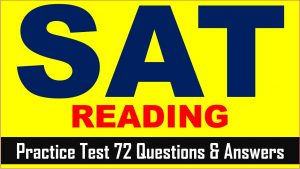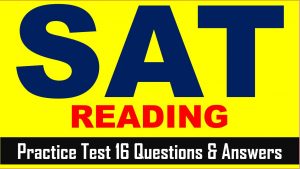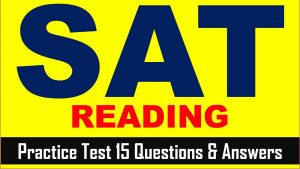Hi SAT Aspirants, welcome to AKVTutorials. As you know SAT (Scholastic Assessment Test) is a standard test, used for taking admission to undergraduate programs of universities or colleges of United States. SAT is developed and published by the College Board, an organization in United States, administered by the Educational Testing Service. Are you searching for SAT Reading Practice Questions? Then, in this article of AKVTutorials, you will get SAT Reading Practice Test 61 | SAT 2024 Online Tutor AMBiPi.
SAT Reading Practice Passage
SAT Reading Practice Test Comprehensive Passage
This passage is adapted from tony Schwartz, “why you hate work” by the New York Times 2010. The following 10 multiple choice questions are based on the passage below.
| The way we’re working isn’t working. Even if you are lucky | |
| enough to have a job, you are probably not very excited to get | |
| to the office in the morning, you don’t feel much appreciated | |
| while you’re there, you find it difficult to get your most | |
| Line 5 | important work accomplished, amid all the distractions, and |
| you don’t believe that what you’re doing makes much of a | |
| difference anyway. By the time you get home, you’re pretty | |
| much running on empty, and yet still answering emails until | |
| you fall asleep. Increasingly, this experience is common not | |
| Line 10 | just to middle managers, but also to top executives. |
| our company, The energy project, Works with organizations | |
| and their leaders to improve employee engagement and more | |
| sustainable performance. A little over a year ago, luke | |
| Kissam, the chief executive of Albemarle, a | |
| Line 15 | multibillion-dollar chemical company sought out one of us |
| Tony, as a coach to help him deal with the sense that his life | |
| was increasingly overwhelming. “I just felt that no matter | |
| what I was doing, I was always getting pulled somewhere | |
| else,” he explained. “it seemed like I was always cheating | |
| Line 20 | someone — my company, my family, myself. I couldn’t truly |
| focus on anything.” | |
| Mr. Kissam is not alone. Srinivasan S. Pillay, a psychiatrist | |
| and an assistant clinical professor at Harvard medical school | |
| who studies burnout, recently surveyed a random sample of | |
| Line 25 | 72 senior leaders and found that nearly all of them reported |
| at least some signs of burnout and that all of them noted at | |
| least one cause of burnout at work. More broadly, just 30 | |
| percent of employees in America feel engaged at work, | |
| according to a 2013 report by Gallup. Around the world, | |
| Line 30 | across 142 countries, the proportion of employees who feel |
| engaged at work is just 13 percent. for most of us, in short, | |
| work is a depleting, dispiriting experience, and in some | |
| obvious ways. it’s getting worse. | |
| Demand for our time is increasingly exceeding our capacity | |
| Line 35 | — draining us of the energy we need to bring our skill and |
| talent fully to life. Increased competitiveness and a leaner, | |
| post-recession work force add to the pressures. the rise of | |
| digital technology is perhaps the biggest influence, exposing | |
| us to an unprecedented flood of information and requests that | |
| Line 40 | we feel compelled to read and respond to all hours of the |
| day and night. | |
| curious to understand what most influences people’s | |
| engagement and productivity at work, we partnered with the | |
| Harvard business review last fall to conduct a survey of | |
| Line 45 | more than 12,000 mostly white-collar employees across a |
| broad range of companies and industries. we also gave the | |
| survey to employees at two of the energy project’s clients | |
| — one a manufacturing company with 6,000 employees, the | |
| other a financial services company with 2,500 employees. | |
| Line 50 | The result were remarkably similar across all three |
| populations. Employees are vastly more satisfied and | |
| productive turns out When four of their core needs are met: | |
| physical, through opportunities to regularly renew and | |
| recharge at work; emotional, by feeling valued and | |
| Line 55 | appreciated for their contributions; mental, when they have |
| the opportunity to focus in an absorbed way on their most | |
| important tasks and define when and where they get their | |
| work done, and spiritual, by doing more of what they do best | |
| and enjoy most, and by feeling connected to a higher purpose | |
| Line 60 | at work. |
| the more effectively leaders and organizations support | |
| employees in meeting these core needs, the more likely the | |
| employees are to experience engagement, loyalty, job | |
| satisfaction and positive energy at work, and the one need | |
| Line 65 | perceived levels of stress. When employees have one need |
| met, compared with none, all of their | |
| met, compared with none, the more positive the impact. | |
| In specifics, we look at engagement, variously defined as | |
| “involvement, commitment, passion, enthusiasm, focused | |
| Line 70 | effort and energy,” which has now n=been widely correlated |
| with higher corporate performance. in a 2012 meta-analysis | |
| of 263 research studies across 192 companies, Gallup found | |
| those companies in the top quartile for engaged employees, | |
| compared with the bottom quartile, had 22 percent higher | |
| Line 75 | profitability, 10 percent higher customer ratings, 28 percent |
| less theft and 48 percent fewer safety incidents. | |
| A 2012 global work force study of 32,000 employees by the | |
| consulting company towers Watson found that the traditional | |
| definition of engagement — the willingness of employees to | |
| Line 80 | voluntarily expend extra effort – is no longer sufficient to |
| fuel the highest levels of performance. willing, it turns out, | |
| does not guarantee able. Companies in the towers Watson | |
| study with high engagement scores measured In the | |
| traditional way had an operating margin of 14 percent. By | |
| Line 85 | contrast, companies with the highest number of “sustainably” |
| engaged” employees had an operating margin of 27 percent | |
| nearly three times those with the lowest traditional | |
| engagement scores. put simply, the way people feel at work | |
| profoundly influences how they perform. What our study | |
| Line 90 | revealed is just how much impact companies can have when |
| they meet each of the four core needs of their employees. |
SAT Reading Comprehension Practice Test Questions
SAT Reading Practice Test Question No 1
The passages mainly about
Option A : describing methods to gauge factors contributing to engagement in work.
Option B : refuting the seemingly plausible argument of improving employee performance.
Option C : identifying the key factors that cause fatigue in work and anxiety in office spaces.
Option D : evaluating available approaches to study the diminished performance in work places.
SAT Practice Test Answer No 1
Show/Hide Answer
Option A : describing methods to gauge factors contributing to engagement in work.
SAT Reading Practice Test Question No 2
In an overview of the passage, the discussion follows which of the following structures?
Option A : first reporting on a wide scope of incidences then revealing a particular group of people and their experiences.
Option B : First presenting the case in general then analyzing the rationale behind it.
Option C : First describing the burnout experienced by people then examining one specific factor.
Option D : First criticizing a general misconception of certain phenomenon then focusing on concrete examples.
SAT Practice Test Answer No 2
Show/Hide Answer
Option B : First presenting the case in general then analyzing the rationale behind it.
SAT Reading Practice Test Question No 3
According to the passage, which choice refers to the central claim made by the author?
Option A : Lines 22-27(“Mr…work?)
Option B : Lines 34-37 (“Demand…pressure”)
Option C : Lines 61-65 (“the….stress”)
Option D : Lines 67-71 (“The…performance”)
SAT Practice Test Answer No 3
Show/Hide Answer
Option D : Lines 67-71 (“The great longboat … skills”)
SAT Reading Practice Test Question No 4
The author uses the word “empty” in line 8 in order to
Option A : describe the emptiness of mind experienced by the people.
Option B : underscore the exhaustion that usually results from long stressful work.
Option C : reinforce the idea that values and recognition shall be given to employees by leaders.
Option D : demonstrate the intensity of workloads for most of the American white collars.
SAT Practice Test Answer No 4
Show/Hide Answer
Option B : underscore the exhaustion that usually results from long stressful work.
SAT Reading Practice Test Question No 5
In line 32 the article suggests one primary reason why we feel the work is a depleting, dispiriting experience is that
Option A : senior leaders experience way more pressures than regular employees.
Option B : people’s attention are in often times diverted to other areas of higher priorities.
Option C : The post-recession workplaces place higher demands on people’s skills, focuses and talents.
Option D : the influx of information increases the pressure on people’s ability to keep up the work paces.
SAT Practice Test Answer No 5
Show/Hide Answer
Option D: the influx of information increases the pressure on people’s ability to keep up the work paces.
SAT Reading Practice Test Question No 6
which choice provides the best evidence for the answer to the previous questions?
Option A : Lines 22-27 (“Mr…work”)
Option B : Lines 27-31(“more…percent”)
Option C : lines 37-41(“the….night”)
Option D : lines 44-51 (“Harvard…populations”)
SAT Practice Test Answer No 6
Show/Hide Answer
Option C : lines 37-41(“the….night”)
SAT Reading Practice Test Question No 7
in order for the observation in lines 50-51 to be valid,the author relies on which of the following as an assumption?
Option A: All of the three populations in survey produce the same results.
Option B: The time frame for each group of subjects to complete the survey is different.
Option C: The statistical differences shown by the there populations are not significant enough.
Option D: Manufacturing employees are as proper research subjects as those from the financial industry
SAT Practice Test Answer No 7
Show/Hide Answer
Option D : Manufacturing employees are as proper research subjects as those from the financial industry
SAT Reading Practice Test Question No 8
Which choice, if true, will most likely to weaken the statement in lines 61-67?
Option A: among the needs, engagement and loyalty weigh more heavily than job satisfaction and positive energy.
Option B: satisfaction of one of the core needs will substantially impair the effects of spiritual needs.
Option C: Satisfaction of emotional needs will improve at the same time the effect of spiritual needs.
Option D : The core needs in issue function independently in terms of their effects on employees.
SAT Practice Test Answer No 8
Show/Hide Answer
Option B : satisfaction of one of the core needs will substantially impair the effects of spiritual needs.
SAT Reading Practice Test Question No 9
In line 72 of the passage, the gallop findings indicates that
Option A : the percentage of engaged employees will contribute significantly related overall numbers of engaged employees.
Option B : the profitability is not entirely related to the numbers of the engaged employees.
Option C : the safety issues faced by the employees can be successfully moderated with increased engagement.
Option D : the companies participating the survey have low personnel engagement in the history.
SAT Practice Test Answer No 9
Show/Hide Answer
Option C : the safety issues faced by the employees can be successfully moderated with increased engagement.
SAT Reading Practice Test Question No 10
The function of the observation between lines 77-88 in the articles is to
Option A : make a concession of a view made earlier in the passage.
Option B : reinforce the argument of the article by identifying its premises.
Option C : refine the discussion of the central claim with more realistic detaiis.
Option D : elaborate on a specific example to justify the validity of a claim.
SAT Practice Test Answer No 10
Show/Hide Answer
Option C : refine the discussion of the central claim with more realistic detaiis.
SAT Reading Practice Test Question No 11
The quotation mark in lines 85-86 serves best to
Option A : emphasizes the importance of a key term
Option B : highlight the changed meaning of a specific concept.
Option C : borrow strength from an authoritarian source.
Option D : imply a very different connotation of words.
SAT Practice Test Answer No 11
Show/Hide Answer
Option A : emphasizes the importance of a key term
SAT Reading Practice Test Question No 12
According to the article, the author implies which of the following about the traditional definition of engagement?
Option A : It fails to take into consideration of the voluntary power.
Option B : It focuses more on the mental aspect than the competence of the employees.
Option C : It has stayed unaltered for a substantially long period of time.
Option D : It has always been a critical element to evaluate the employee work excellence.
SAT Practice Test Answer No 12
Show/Hide Answer
Option B : It focuses more on the mental aspect than the competence of the employees.
SAT Reading Practice Test Question No 13
Which of the following statements is best supported by the research findings presented in the article?
Option A : The burnout experienced by the people by the people has largely resulted from lack of attentions given from the leaders.
Option B : The higher the spiritual values obtained by the employees, the better they can deliver their work.
Option C : Increases demand for higher academic credentials attests to the reduced engagement of most employees.
Option D : Employees with the best sustainable engagement will usually become more productive.
SAT Practice Test Answer No 13
Show/Hide Answer
Option D : Employees with the best sustainable engagement will usually become more productive.



